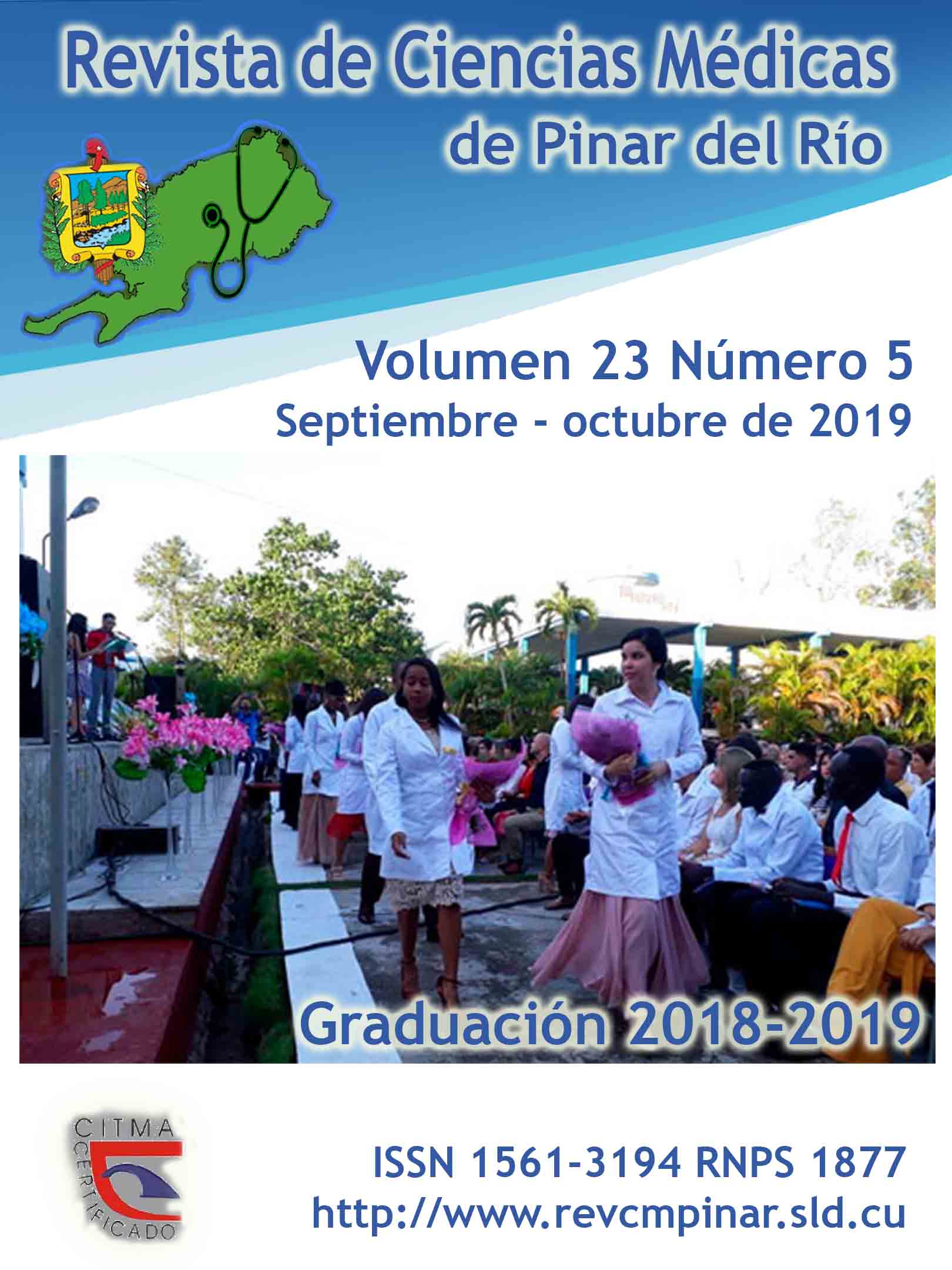Advantages of Nyhus versus Lichtenstein technique for surgical treatment of bilateral inguinal hernia
Keywords:
HERNIA, INGUINAL, SURGICAL PROCEDURES, OPERATIVE, SURGERY DEPARTMENT, HOSPITAL, EPIDEMIOLOGY, RISK FACTORS.Abstract
Introduction: Lichtenstein's and Nyhus techniques represent safe hernioplasties; Nyhus is a procedure not yet reported as the choice for bilateral inguinal hernia.
Objective: to describe the advantages of Lichtenstein technique comparing Nyhus technique for the management of inguinal hernia as the treatment of choice in patients suffering from bilateral inguinal hernia.
Methods: an observational, analytical, and cross-sectional study of control cases was conducted at Abel Santamaría Cuadrado General Teaching Hospital during 2014-2017 in Pinar del Río, Cuba. The sample consisted of 62 cases, in two groups that included 31 patients; Group A: operated by Nyhus technique. Group B: operated in two stages by Lichtenstein technique. Descriptive and inferential statistical tools were applied.
Results: in group A, the standard surgical time was 42 minutes, group B was over 60, the chi-square statistician showed the non-homogeneity between the frequencies being statistically significant the difference when observing the value of p=0.00020. The hospitalization time in A averaged 26 hours, in group B predominated more than 48 hours, the statistician chi-square showed the non-homogeneity between the frequencies being statistically significant the difference when observing the value of p=0.00000059. The ratio of complications of group A and B was 1.57. Patients belonging to Group A had no recurrence or inguinodynia symptoms, patients from Group B presented 3 inguinodynia episodes.
Conclusions: Nyhus technique is the preferred choice for surgical treatment of bilateral inguinal hernia.
Downloads
References
1. Casamayor Callejas E, Legrá Legrá J, Danger Durán M, Pardo Olivares E. Características clínicas y epidemiológicas en pacientes operados de hernias inguinales. MEDISAN [Internet]. 2018 Jun [citado 18/02/2019]; 22(6): [aprox. 7p.]. Disponible en: http://scielo.sld.cu/scielo.php?script=sci_arttext&pid=S1029-30192018000600003&lng=es.Pérez
2. Pérez Espinoza E. PERFIL EPIDEMIOLÓGICO DE HERNIAS ABDOMINALES EN PACIENTES DEL HOSPITAL ABEL GILBERT [Internet]. Guayaquil; 2018 [citado 26/12/2018]. Disponible en: http://repositorio.ug.edu.ec/bitstream/redug/31400/1/PEREZ%20ESPINOZA%20EDUARDO%20BELISARIO.pdf
3. Dávila Dorta D. La «invasividad» de las técnicas quirúrgicas en el tratamiento de las hernias de la región inguinal. Revista Hispanoamericana de Hernia. [Internet]. 2016 [citado 18/02/2019]; 4(3): [aprox. 8p.]. Disponible en: http://www.sciencedirect.com/science/article/pii/S2255267716300159
4. Granda Ana C, Correa-Tineo Santos, Quispe Antonio M. Herniorrafía con la técnica de Lichtenstein versus Nyhus en el manejo de las hernias inguinales y sus complicaciones postoperatorias en un hospital del Perú. Acta méd. Peru [Internet]. 2016 Jul [citado 27/12/2018]; 33(3): [aprox. 8p.]. Disponible en: http://www.scielo.org.pe/scielo.php?script=sci_arttext&pid=S1728-59172016000300007&lng=es.
5. Cachi Jurado RJ. BENEFICIOS DE LA TÉCNICA NYHUS FRENTE A LA LICHTENSTEIN EN HERNIAS INGUINALES HOSPITAL NACIONAL ARZOBISPO LOAYZA-2016. [Tesis]. Lima-Perú; 2017. Disponible en: http://www.repositorioacademico.usmp.edu.pe/bitstream/usmp/3392/3/cachi_jrj.pdf
6. Correa Martínez L, Domínguez Rodríguez DL. Epidemiología de pacientes afectos de hernia inguinal bilateral. Rev Ciencias Médicas [Internet]. 2018 Jun [citado 27/12/2018]; 22(3): [aprox. 7p.]. Disponible en: http://scielo.sld.cu/scielo.php?script=sci_arttext&pid=S1561-31942018000300009&lng=es.
7. Porro Novo N. Homeostasis. EN: Pardo Gómez G, García Gutiérrez. Temas de Cirugía Tomo I. La Habana: Editorial Ciencias Médicas; 2010. p 1-8
8. Matzke G, Espil G, Dos Ramos Alferes JP, Larrañaga N, Oyarzún A, Kozima S. Un recorrido por la pared abdominal: evaluación de las hernias por tomografía computada multidetector. Revista Argentina de Radiología. [Internet]. January–March 2017 [citado 27/12/2018]; 81(1): [aprox. 10p.]. Disponible en: https://www.sciencedirect.com/science/article/pii/S0048761916300278
9. Caraballoso García VJ, Casanova Pérez PA, Galloso Cueto GL, Santana González-Chávez A, Orea Cordero I, Caraballoso García L. Resultados del tratamiento quirúrgico de los pacientes operados de hernia inguinocrural. Rev.Med.Electrón. [Internet]. 2016 Ago [citado 18/02/2019]; 38(4): [aprox. 11p.]. Disponible en: http://scielo.sld.cu/scielo.php?script=sci_arttext&pid=S1684-18242016000400006&lng=es.
10. Destek S, Onur Gul V. Comparison of Lichtenstein Repair and Mesh Plug Repair Methods in The Treatment of Indirect Inguinal Hernia. Cureus. [Internet]. 2018 Jul [citado 18/02/2019]; 10(7). Disponible en: https://www.ncbi.nlm.nih.gov/pmc/articles/PMC6128592/
11. Molina Fernández EJ, de la Paz Mora O, Arias Larios L, García Sierra JC, Tamayo Gandol Y. Infecciones en cirugía herniaria bioprotésica. Rev Cubana Cir [Internet]. 2014 Dic [citado 18/02/2019]; 53(4): [aprox. 4p.]. Disponible en: http://scielo.sld.cu/scielo.php?script=sci_arttext&pid=S0034-74932014000400011&lng=es.
12. Rodríguez Ginarte T, Vidal Machado D. Anestesia epidural y anestesia espinal en pacientes cesareadas. Multimed [Internet]. 2013 Dic [citado 18/02/2019]; 17(2): [aprox. 13p.]. Disponible en: http://www.revmultimed.sld.cu/index.php/mtm/article/view/293/391
Published
How to Cite
Issue
Section
License
Authors who have publications with this journal agree to the following terms: Authors will retain their copyrights and grant the journal the right of first publication of their work, which will be publication of their work, which will be simultaneously subject to the Creative Commons Attribution License (CC-BY-NC 4.0) that allows third parties to share the work as long as its author and first publication in this journal are indicated.
Authors may adopt other non-exclusive license agreements for distribution of the published version of the work (e.g.: deposit it in an institutional telematic archive or publish it in a volume). Likewise, and according to the recommendations of the Medical Sciences Editorial (ECIMED), authors must declare in each article their contribution according to the CRediT taxonomy (contributor roles). This taxonomy includes 14 roles, which can be used to represent the tasks typically performed by contributors in scientific academic production. It should be consulted in monograph) whenever initial publication in this journal is indicated. Authors are allowed and encouraged to disseminate their work through the Internet (e.g., in institutional telematic archives or on their web page) before and during the submission process, which may produce interesting exchanges and increase citations of the published work. (See The effect of open access). https://casrai.org/credit/



